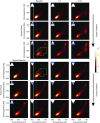Unstable Inflation Causing Injury. Insight from Prone Position and Paired Computed Tomography Scans
- PMID: 29420904
- PMCID: PMC6058981
- DOI: 10.1164/rccm.201708-1728OC
Unstable Inflation Causing Injury. Insight from Prone Position and Paired Computed Tomography Scans
Abstract
Rationale: It remains unclear how prone positioning improves survival in acute respiratory distress syndrome. Using serial computed tomography (CT), we previously reported that "unstable" inflation (i.e., partial aeration with large tidal density swings, indicating increased local strain) is associated with injury progression.
Objectives: We prospectively tested whether prone position contains the early propagation of experimental lung injury by stabilizing inflation.
Methods: Injury was induced by tracheal hydrochloric acid in rats; after randomization to supine or prone position, injurious ventilation was commenced using high tidal volume and low positive end-expiratory pressure. Paired end-inspiratory (EI) and end-expiratory (EE) CT scans were acquired at baseline and hourly up to 3 hours. Each sequential pair (EI, EE) of CT images was superimposed in parametric response maps to analyze inflation. Unstable inflation was then measured in each voxel in both dependent and nondependent lung. In addition, five pigs were imaged (EI and EE) prone versus supine, before and (1 hour) after hydrochloric acid aspiration.
Measurements and main results: In rats, prone position limited lung injury propagation and increased survival (11/12 vs. 7/12 supine; P = 0.01). EI-EE densities, respiratory mechanics, and blood gases deteriorated more in supine versus prone rats. At baseline, more voxels with unstable inflation occurred in dependent versus nondependent regions when supine (41 ± 6% vs. 18 ± 7%; P < 0.01) but not when prone. In supine pigs, unstable inflation predominated in dorsal regions and was attenuated by prone positioning.
Conclusions: Prone position limits the radiologic progression of early lung injury. Minimizing unstable inflation in this setting may alleviate the burden of acute respiratory distress syndrome.
Keywords: acute respiratory distress syndrome; computed tomography; parametric response mapping; prone position ventilation; ventilator-associated lung injury.
Figures







Comment in
-
Unstable Inflation Is Harmful and More Common Supine Than Prone.Am J Respir Crit Care Med. 2018 Jul 15;198(2):146-147. doi: 10.1164/rccm.201802-0313ED. Am J Respir Crit Care Med. 2018. PMID: 29494780 No abstract available.
References
-
- Bellani G, Laffey JG, Pham T, Fan E, Brochard L, Esteban A, et al. LUNG SAFE Investigators; ESICM Trials Group. Epidemiology, patterns of care, and mortality for patients with acute respiratory distress syndrome in intensive care units in 50 countries. JAMA. 2016;315:788–800. - PubMed
-
- Brower RG, Matthay MA, Morris A, Schoenfeld D, Thompson BT, Wheeler A Acute Respiratory Distress Syndrome Network. Ventilation with lower tidal volumes as compared with traditional tidal volumes for acute lung injury and the acute respiratory distress syndrome. N Engl J Med. 2000;342:1301–1308. - PubMed
-
- Slutsky AS, Ranieri VM. Ventilator-induced lung injury. N Engl J Med. 2013;369:2126–2136. - PubMed
-
- Guérin C, Reignier J, Richard J-C, Beuret P, Gacouin A, Boulain T, et al. PROSEVA Study Group. Prone positioning in severe acute respiratory distress syndrome. N Engl J Med. 2013;368:2159–2168. - PubMed
-
- Gattinoni L, Tognoni G, Pesenti A, Taccone P, Mascheroni D, Labarta V, et al. Prone-Supine Study Group. Effect of prone positioning on the survival of patients with acute respiratory failure. N Engl J Med. 2001;345:568–573. - PubMed
Publication types
MeSH terms
Grants and funding
LinkOut - more resources
Full Text Sources
Other Literature Sources

